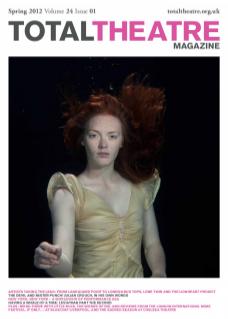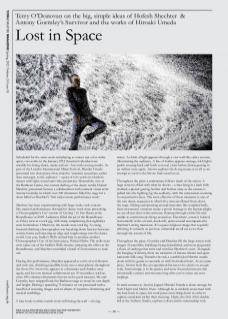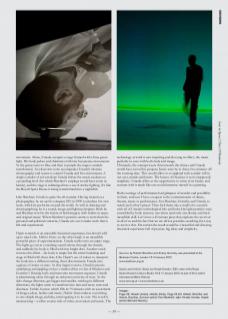Scheduled for the same week and playing at venues just a few miles apart, two works in the January 2012 theatrical calendar were notable for fusing dance, music and art – but with varying results. As part of the London International Mime Festival, Hiroaki Umeda presented two short pieces that aimed to ‘transmit sensations, rather than messages, to the audience’ – a pair of solo works in which he dances with light, sound and video projection. Meanwhile, over at the Barbican Centre, the current darling of the dance world, Hofesh Shechter, presented Survivor, a collaboration with eminent visual artist Antony Gormley in which over 100 drummers filled the stage for a show billed as Shechter’s ‘first major music performance work’.
Shechter has been experimenting with large-scale, rock-concertlike musical performances through his dance work since presenting a ‘Choreographer’s Cut’ version of Uprising / In Your Rooms at the Roundhouse in 2009. Audiences filled the pit of the Roundhouse as if they were at a rock gig, with many complaining that sightlines were horrendous. Otherwise, the results were exciting. A young, forward-thinking choreographer was breaking down barriers between artistic forms and injecting an edgy and rough energy into the dance world. Last year, Sadler’s Wells invited him to produce another ‘Choreographer’s Cut’ of his latest piece, Political Mother. The stalls seats were taken out of the Sadler’s Wells theatre, imitating the effect at the Roundhouse, and Shechter assembled a band of 24 musicians to rock out.
During this performance, Shechter appeared as a mix of evil dictator and rock star, shrieking inaudible lyrics into a microphone throughout the show. For Survivor he appears as a drummer and shrieker once again, and his core musical collaborators are 30 in number, with an extra 100 volunteer drummers thrown in for good measure. He and Gormley have stripped back the Barbican stage to reveal its vast depth and height. During a sprawling 75 minutes we are presented with a handful of stunning images and an album of repetitive drumming and musical ramblings.
A lone body in white stands stock-still facing the wall – a living statue. A chink of light appears through a vast wall-like safety curtain, illuminating the audience. A line of bodies appears onstage, with lights gently swaying back and forth to reveal a face before disintegrating to an outline once again. Survivor explores the living statue in us all as we attempt to survive the life we find ourselves in.
Throughout the piece a cameraman follows much of the action. A huge screen is filled with what he shoots – a man lying in a bath fully clothed; a pianist getting further and further away as the camera is pulled into the lighting rig; the audience, with the cameraman zooming in on particular faces. The most effective of these moments is one of the rare dance sequences in which five men are filmed from above the stage. Sliding and spinning around meteorite-like weighted balls, their movements onscreen create a poetic homage to the human plight: we are all tiny dots in the universe, floating through a little life and unable to control many things around us. Elsewhere, a man is hoisted horizontally in the air and, stock-still, spins around accompanied by Shechter’s string musicians. It’s a quasi-religious image that is quietly affecting. It reminds us just how vulnerable we all are as we float through the terrain of life.
Throughout the piece, Gormley and Shechter fill the large screen with images of waterfalls, buildings being demolished, and most poignantly a flock of starlings that twist and turn like Shechter’s score. Alongside the banging of drums, there are moments of intense silence and quiet lonesome folk song. Towards the end, a youthful Joel Harries stands alone with his guitar to serenade us with his broken heart. As an entire piece, Survivor feels like an experiment between two artists on an epic scale. Interestingly, it is the quieter and more focused moments that emotionally connect and resonate long after you’ve taken out your earplugs.
In stark contrast to Survivor, Japan’s Hiroaki Umeda is alone onstage for both Haptic and Holistic Strata. Although he is similarly concerned with the lone body in space, his work pares everything down in order to explore sensations rather then meaning. Haptic, the first of his double bill at the Linbury Studio, explores colour and its relationship with movement. Alone, Umeda occupies a stage framed with a lime green light. His body pulses and shimmers with tiny but precise movements. As the green turns to blue and then to purple the stage is entirely transformed. An electronic score accompanies Umeda’s intricate choreography and seems to control Umeda and his environment. A single corridor of red envelops Umeda before the music escalates to a pounding level (for which Shechter’s earplugs would have come in handy), and the stage is submerged into a sea of strobe lighting. It’s like the Royal Opera House is being transformed into a nightclub.
Like Shechter, Umeda is quite the all-rounder. Having trained as a photographer, he set up his company S20 in 2000 to produce his own work, which he performs around the world. As well as dancing and choreographing, he is a sound, image and lighting designer. Both he and Shechter revel in the fusion of bold imagery with bodies in space and original music. Where Shechter’s practice seems to stem from his personal and political concerns, Umeda sets out to make work that is felt and experienced.
Haptic certainly is an enjoyable theatrical experience, but doesn’t add up to much else. Holistic Strata, on the other hand, is an incredibly powerful piece of experimentation. Umeda walks onto an empty stage. The lights go out as a crashing sound echoes through the theatre, and suddenly his body is filled with tiny bright dots. Another crash reverses the effect – his body is empty but the entire backdrop and stage is filled with these dots. Like Haptic’s use of colour to transport the body into a different setting, these dots immerse Umeda into a galaxy of atoms or stars. As they begin to move, Umeda’s precise undulating and rippling evokes a similar effect to that of Shechter and Gormley’s floating body and meteorite movement sequence. Umeda is plummeting alone through an unknown universe of stars. As the dots change direction, get bigger and smaller, swirling in different directions, the lights seem to transform into rain and snow, tears and dizziness. Unlike Survivor, which fills its 75 minutes with an assortment of images, ideas, bodies and music, Holistic Strata reduces everything to one simple image and idea, interrogating it to its core. The result is mesmerising – a roller-coaster ride of video, movement and music. The technology at work is awe-inspiring and dizzying in effect, the music perfectly in sync with both body and image.
Ultimately, the concept wears thin towards the climax and Umeda would have served his purpose better were he to shave five minutes off the running time. This would allow us to applaud with wonder still in our eyes, minds and hearts. The beauty of the piece is in its (supposed) simplicity: Umeda offers us the opportunity to swim in its beauty and connect with it much like one would immerse oneself in a painting.
Both evenings of performance had glimpses of wonder and possibility in them, and now I have a request to the commissioners of dance, theatre, music or performance. Get Shechter, Gormley and Umeda to watch each other’s pieces. Then lock them into a studio for a month with all of Umeda’s technological bits and bobs (the light particles were controlled by body sensors), one drum (and only one drum), and their incredible skill. Let’s have a 45 minute piece that explores the survivor in all of us and the fact that we are all lost particles searching for a way to survive this. I’m certain the result would be a beautiful and dizzying theatrical experience full of passion, big ideas and simplicity.
Survivor, by Hofesh Shechter and Antony Gormley, was presented at the Barbican Centre, London 12-14 January 2012. www.barbican.org.uk
Haptic and Holistic Strata, by Hiroaki Umeda / S20, were at the Royal Opera House’s Linbury Studio 16 & 17 January 2012 as part of the London International Mime Festival. www.roh.org.uk / www.mimefest.co.uk


